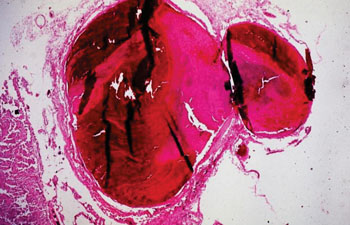Simplified Assay Quantifies Circulating Activated Protein C
By LabMedica International staff writers
Posted on 24 Aug 2016
The protein C (PC) anticoagulant pathway plays a crucial role in the regulation of fibrin formation by inactivating the pro-coagulant cofactors factor Va and factor VIIIa.Posted on 24 Aug 2016
The physiological relevance of PC in the regulation of blood coagulation arises from the description of increased risk of venous thromboembolism (VTE) associated with both hereditary PC deficiency and low circulating activated protein C (APC) levels. Available assays for circulating levels of APC are either time-consuming or difficult to use in a routine laboratory, or have a detection limit above normal levels.

Image: A histopathology of brain tissue showing acute venous thromboembolism of unknown etiology (Photo courtesy of Peter Anderson).
Scientists at the Instituto de Investigación Sanitaria La Fe (Valencia, Spain) developed a simplified assay that measures both the in vivo free APC and the in vivo APC complexed to PC inhibitor (PCI). They measured APC levels, with both assays, in 339 plasma samples, 165 from patients with venous thromboembolism (VTE) and 174 from healthy individuals.
The PCI antigens were determined and PCI concentration was expressed in nM, assuming a molecular weight for PCI of 57,000 and a concentration of plasma PCI, in pooled normal plasma, of 87.7 nM. APC: PCI complexes were determined by a sandwich enzyme-linked immunosorbent assay (ELISA). Microplates were coated with a monoclonal antibody to PC and complexes were detected with peroxidase-labeled polyclonal antibodies to PCI. APC concentration in the complex is expressed in nM, assuming a molecular weight of APC of 57,000.
The investigators found that the mean APC level in the 339 samples was 0.038 ± 0.010 nM, using a previous assay that measures only the in vivo APC level, and 0.041 ± 0.010 nM with the present new assay. The mean APC level in VTE patients was 0.034 ± 0.009 nM (previous assay) and 0.037 ± 0.009 nM (new assay), significantly lower than those in controls. In both groups there was a significant correlation between the levels obtained by the two assays.
The authors concluded that their results show that both assays are equivalent, and confirm that the APC level is lower in VTE patients than in healthy individuals. Therefore, the new simplified assay, which measures the sum of circulating free APC and APC complexed to PCI, may be used to estimate the level of circulating APC, and will allow its use in routine laboratories. The study was published on August 1, 2016, in the journal Clinica Chimica Acta.
Related Links:
Instituto de Investigación Sanitaria La Fe














